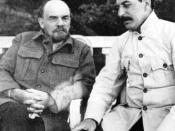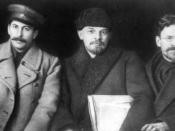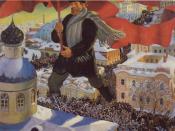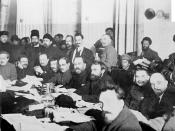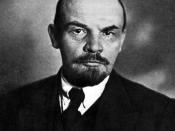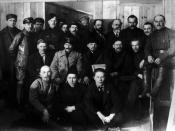The Russian Revolution as a whole was completely built around Marxism and the Marxist theory. This theory instructs that a perfect political system is reached when every single citizen of a nation has the same amount of property as every one of his fellow citizens. This system can be achieved by creating a Dialectic. A Dialectic is when a thesis (in this case the upper class society) is combined with an antithesis (in this case the lower class society) to form a synthesis (an overall middle class society). This would eliminate every kind of class struggle and make everyone an equal member of a country, both socially and politically. In Marxist terms, this equality is known as "freedom for all". Throughout the Russian Revolution, there were many powerful leaders which tried, through force, to install a new political system based upon the Marxist theory, called Communism. Although the leaders were fairly successful in their undertakings, they sometimes forgot about the basic principles that had been set up to make Communism a total success.
In this essay, I will try to distinguish the better communist between the two most famous revolutionary leaders of Russia: Vladimir Lenin and Joseph Stalin.
The Bolshevik party was a small party when it seized power. It had to adopt strong tactics to maintain its power. With Lenin as its leader, the Bolsheviks adjusted their policy to solve the needs of the people in order to stay in power. The Bolsheviks changed their name to Russian Communist Party of the Bolsheviks in March 1918 when the seventh Congress of the Bolshevik Party was held. As soon as Lenin came to power, he passed a series of decrees to satisfy the immediate wants of the Russian people. These included giving land to the peasants, giving control of the factories to the workers, the introduction of 8-hour day, repudiation of foreign debts and secret treaties, and the beginning of an effort to make peace with Germany. The decrees that legalized the seizure of land by the peasants and allowed workers to control the factories won most support from the people as their life-long wishes suddenly came true. Lenin understood that many Russians had hoped for the election of a Constituent Assembly. In November, the nation-wide election for the Constituent Assembly was held. The Bolsheviks won only ÃÂü of the votes in this election. After the Assembly had sat for one and a half day, Lenin ordered the Red Guards to disperse it by force.
After winning the Civil War between his "Reds" and the "White" Social Revolutionaries, Lenin saw that Russia was in a deep economic crisis. The first and most important problem facing him was to restore order and wealth out of the immediate social and economic chaos. In agriculture, the peasants did not show any motivation to grow their crops anymore, as their produce was confiscated immediately to feed the town workers and the soldiers. Some rich landowners refused to hand in their crops to the soldiers. From 1918 to 1920, about 6 million died of starvation, hunger and cold. In sympathy with the hungry Russians, the American Relief Administration sent goods to Russia and saved many lives. After the Kronstadt Uprising of March 1921, Lenin saw that the situation was dangerous. The living conditions of the people were too bad. As a result Lenin proclaimed, "Everything must be set aside to increase production." He declared the "Retreat from Communism" and in 1921, introduced the New Economic Policy (NEP). From then on, the confiscation of the peasants' goods was stopped. They could sell their crops in the market after they had paid a tax on their produce. They were given permission to sell or lease their own land and even hire laborers to work on their own land. By 1928, Russian agricultural and industrial production went back to their 1914 level. The N.E.P. had successfully calmed the economic anger of the Russian people. However, Lenin never had the chance to see the entire successes of his new economic policy. In 1922 and 1923, he had a series of strokes and at the beginning of 1924, he died.
After Lenin's death in early 1924, there was a struggle for power among the top-level members of the Communist Party - Trotsky, Stalin, Zinoviev, Bukharin and Kamenev. In his will, Lenin did not mention anyone to succeed him as the leader of the Party and the country. Trotsky remained in the Caucasus to recover from an illness and failed to attend the funeral in Moscow. Stalin immediately opened a press campaign against Trotsky and dishonored him. In 1927, Trotsky, Zinoviev and Kamenev were expelled from the party. Having removed his political opponents from power, Stalin dealt with Bukharin and expelled him from the party in 1928 in 1929, Trotsky was deported from Russia and in 1940, was assassinated in Mexico. At last, Stalin gained complete power for himself in 1927.
Stalin thought that rapid industrialization and collectivization of agriculture would turn Russia into a rich and strong socialist state. He made use of the State Planning Commission (Gosplan) to make a survey of the country's economic resources. Targets were then set for each of the industries and each of the collective farms. The industries and the farms had to increase their rates of production according to these targets. Collectivization of agriculture meant that private farms were abolished. In its place large farms were set up. They were run by a number of families under the control of government officials. The kind of crops and the amount of production were decided by the needs of the district and the state. Machines were introduced to raise productivity of the land. By developing heavy industries, Russia hoped that it could first free itself from dependence on capitalist states for machinery and manufactured goods, and finally rival with the industrial production of the United States and Germany. Also, if Russia was economically strong, it could have the money to produce more powerful weapons that could defend itself from any possible attacks by foreign enemies.
The First Five Year Plan ran from 1928 to 1932 in order to strengthen the development of heavy industries (coal-mining industries, the building of power-stations and tractors, and machine construction). The aims of the First Five Year Plan were declared achieved in 4 years. In 1932, the output of Russian industry more than doubled the pre-war level. The Second (1933-1937) and the Third (1939-1943) Five Year Plans were focused at the development of light industries with the production of more consumer goods. As the Plans were carried out, war threat was increasing. As a result, much attention was shifted to heavy industries again. Light industry was neglected and armaments were produced in great quantities. In 1936, electricity output was 16 times than that of 1913. The output of coal, steel and iron also increased by at least three times than in 1913. As a result of the Five Year Plans, by the end of the 1930's, Russia had become a major industrial power.
People might argue about who was the better communist. Was it Lenin, or was it Stalin? After having written this essay, I am confident that Lenin was definitely the better leader. Lenin cared about his citizens, and he changed to the N.E.P. just in time to prevent Russia from running down the drain. However, it was Stalin, who since his appearance at the head of the Bolshevik party, followed the Communist and Marxist ideals through to the end. In order for a communist country to run successfully, it needs an extremely ruthless and cold-blooded leader. Stalin was this ruthless and cold-blooded leader. It is therefore, that Stalin was undoubtedly the perfect communist leader.
---------------------------------------------------- Ben Walsh, G C S E MODERN WORLD History (1996) 90.
Walsh 90.
Encylopedia.com, "Russian Revolution," http://www.encyclopedia.com/articles/11250.html.
YUSU EssayBank, "Essay on the Russian Revolution," http://www.york.ac.ok/student/su/essaybank/index.shtml.
Encylopedia.com, "Russian Revolution," http://www.encyclopedia.com/articles/11250.html.
Encylopedia.com, "Russian Revolution," http://www.encyclopedia.com/articles/11250.html.
Walsh 101-103.
